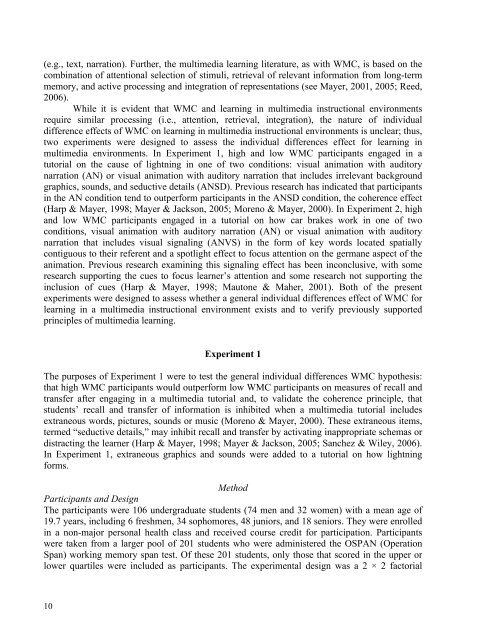Journal of Research in Innovative Teaching - National University
Journal of Research in Innovative Teaching - National University
Journal of Research in Innovative Teaching - National University
Create successful ePaper yourself
Turn your PDF publications into a flip-book with our unique Google optimized e-Paper software.
(e.g., text, narration). Further, the multimedia learn<strong>in</strong>g literature, as with WMC, is based on the<br />
comb<strong>in</strong>ation <strong>of</strong> attentional selection <strong>of</strong> stimuli, retrieval <strong>of</strong> relevant <strong>in</strong>formation from long-term<br />
memory, and active process<strong>in</strong>g and <strong>in</strong>tegration <strong>of</strong> representations (see Mayer, 2001, 2005; Reed,<br />
2006).<br />
While it is evident that WMC and learn<strong>in</strong>g <strong>in</strong> multimedia <strong>in</strong>structional environments<br />
require similar process<strong>in</strong>g (i.e., attention, retrieval, <strong>in</strong>tegration), the nature <strong>of</strong> <strong>in</strong>dividual<br />
difference effects <strong>of</strong> WMC on learn<strong>in</strong>g <strong>in</strong> multimedia <strong>in</strong>structional environments is unclear; thus,<br />
two experiments were designed to assess the <strong>in</strong>dividual differences effect for learn<strong>in</strong>g <strong>in</strong><br />
multimedia environments. In Experiment 1, high and low WMC participants engaged <strong>in</strong> a<br />
tutorial on the cause <strong>of</strong> lightn<strong>in</strong>g <strong>in</strong> one <strong>of</strong> two conditions: visual animation with auditory<br />
narration (AN) or visual animation with auditory narration that <strong>in</strong>cludes irrelevant background<br />
graphics, sounds, and seductive details (ANSD). Previous research has <strong>in</strong>dicated that participants<br />
<strong>in</strong> the AN condition tend to outperform participants <strong>in</strong> the ANSD condition, the coherence effect<br />
(Harp & Mayer, 1998; Mayer & Jackson, 2005; Moreno & Mayer, 2000). In Experiment 2, high<br />
and low WMC participants engaged <strong>in</strong> a tutorial on how car brakes work <strong>in</strong> one <strong>of</strong> two<br />
conditions, visual animation with auditory narration (AN) or visual animation with auditory<br />
narration that <strong>in</strong>cludes visual signal<strong>in</strong>g (ANVS) <strong>in</strong> the form <strong>of</strong> key words located spatially<br />
contiguous to their referent and a spotlight effect to focus attention on the germane aspect <strong>of</strong> the<br />
animation. Previous research exam<strong>in</strong><strong>in</strong>g this signal<strong>in</strong>g effect has been <strong>in</strong>conclusive, with some<br />
research support<strong>in</strong>g the cues to focus learner’s attention and some research not support<strong>in</strong>g the<br />
<strong>in</strong>clusion <strong>of</strong> cues (Harp & Mayer, 1998; Mautone & Maher, 2001). Both <strong>of</strong> the present<br />
experiments were designed to assess whether a general <strong>in</strong>dividual differences effect <strong>of</strong> WMC for<br />
learn<strong>in</strong>g <strong>in</strong> a multimedia <strong>in</strong>structional environment exists and to verify previously supported<br />
pr<strong>in</strong>ciples <strong>of</strong> multimedia learn<strong>in</strong>g.<br />
Experiment 1<br />
The purposes <strong>of</strong> Experiment 1 were to test the general <strong>in</strong>dividual differences WMC hypothesis:<br />
that high WMC participants would outperform low WMC participants on measures <strong>of</strong> recall and<br />
transfer after engag<strong>in</strong>g <strong>in</strong> a multimedia tutorial and, to validate the coherence pr<strong>in</strong>ciple, that<br />
students’ recall and transfer <strong>of</strong> <strong>in</strong>formation is <strong>in</strong>hibited when a multimedia tutorial <strong>in</strong>cludes<br />
extraneous words, pictures, sounds or music (Moreno & Mayer, 2000). These extraneous items,<br />
termed “seductive details,” may <strong>in</strong>hibit recall and transfer by activat<strong>in</strong>g <strong>in</strong>appropriate schemas or<br />
distract<strong>in</strong>g the learner (Harp & Mayer, 1998; Mayer & Jackson, 2005; Sanchez & Wiley, 2006).<br />
In Experiment 1, extraneous graphics and sounds were added to a tutorial on how lightn<strong>in</strong>g<br />
forms.<br />
Method<br />
Participants and Design<br />
The participants were 106 undergraduate students (74 men and 32 women) with a mean age <strong>of</strong><br />
19.7 years, <strong>in</strong>clud<strong>in</strong>g 6 freshmen, 34 sophomores, 48 juniors, and 18 seniors. They were enrolled<br />
<strong>in</strong> a non-major personal health class and received course credit for participation. Participants<br />
were taken from a larger pool <strong>of</strong> 201 students who were adm<strong>in</strong>istered the OSPAN (Operation<br />
Span) work<strong>in</strong>g memory span test. Of these 201 students, only those that scored <strong>in</strong> the upper or<br />
lower quartiles were <strong>in</strong>cluded as participants. The experimental design was a 2 × 2 factorial<br />
10

















